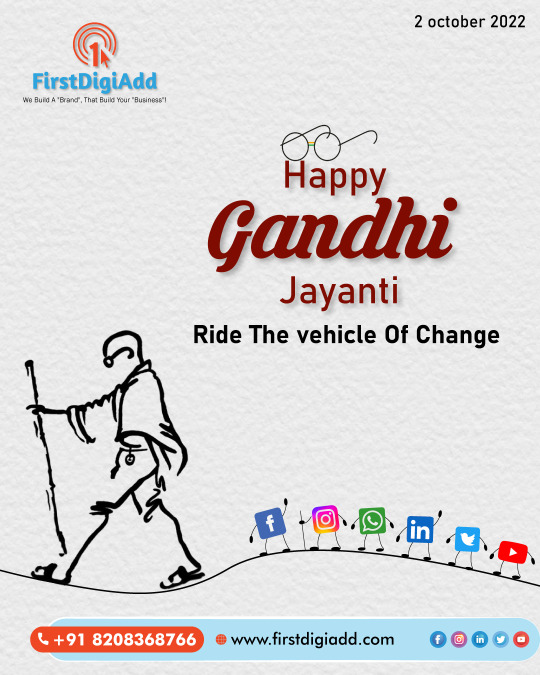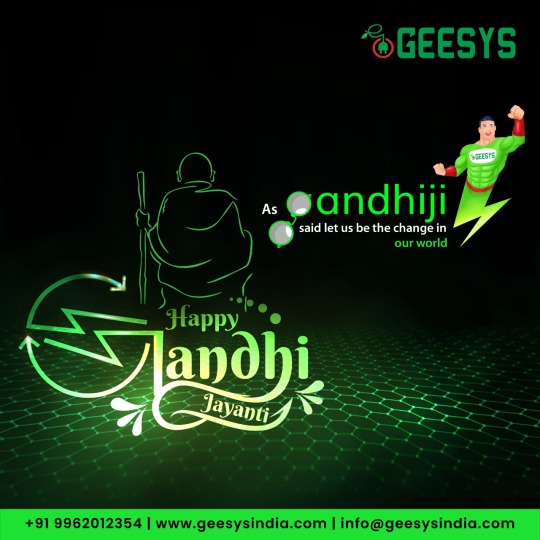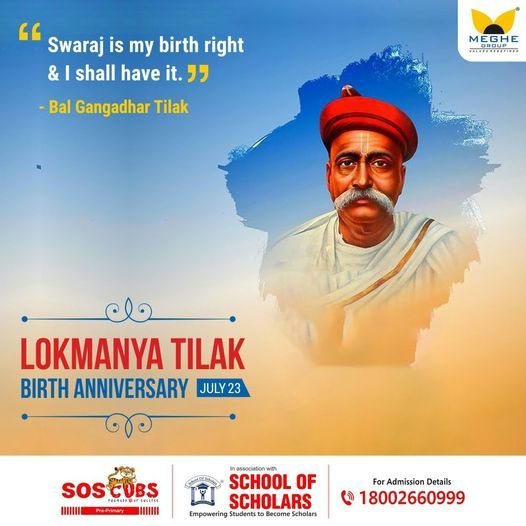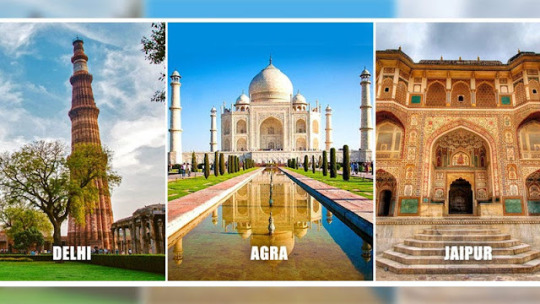#Father of Nation Mahatma Gandhi
Photo

Happy Gandhi Jayanti 2022
Celebrating the day which teaches us the importance of non-violence by remembering the great leader of our Nation Mahatma Gandhi. Happy Gandhi Jayanti
#Happy Gandhi Jayani#gandhi jayanti 2022#Mahatma Gandhi#non-violence#Father of Nation Mahatma Gandhi
4 notes
·
View notes
Text
youtube
0 notes
Photo

Happy Gandhi Jayanti to all
As Gandhiji said let us be the change in our world
#geesystechnologies#bapuji#gandhiji#mahatma#mahatma gandhi#freedom fighter#nonviolence#peace#peacemaker#october2#celebration#celebrations#father of the nation#mahatmagandhi
0 notes
Photo

Strength does not come from physical capacity, It comes from an indomitable will. Happy Gandhi Jayanti to all!
#gandhi jayanti#mahatma gandhi#gandhi#india#gandhiji#gandhiquotes#october#happy gandhi jayanti#fatherofthenation#gandhi jayanti special#father of nation
0 notes
Link
Mohan Das Karam Chand Gandhi’s actions have garnered him several monikers and descriptions throughout the world, including the hero, social activist, fanatic, lobbyist and peacemaker.
0 notes
Text
DAY 5347
Jalsa, Mumbai Oct 2, 2022 Sun 11:33 PM
💜 ,
Birthday wishes for the 3rd to Ef Prashant Kawadia .. Prashant .. your dedication and affection is supreme .. I am humbled .. be well and happy .. 🌷
💜 ,
October 2nd is birthday of Ef Linda Twigg from UK 🇬🇧 .. sharer of birth with the Father of the Nation, Mahatma Gandhi .. greetings, Linda and happiness to you .. 🌷
And belated wishes to Ef Hassan Esmail aka Mr. Lol from the Alex of Egypt 🇪🇬 .. his birthday on October 1st .. 🌷
another delay .. of sorts .. of work delayed .. of cause .. and the commitment towards the campaign of an importance where the Ambassadorship needs attention and time ..
so 14 hrs of a telethon .. non stop ..

and my wishes for a pleasant night .. and love ❤️❤️❤️

Amitabh Bachchan
✨
123 notes
·
View notes
Photo

Mahatma Gandhi leaving the British viceroy’s residence in Simla, 1945 © Hulton-Deutsch Collection/Corbis/Getty Images
* * * *
India Against Ghandi :: A Legacy Rewritten
Ramachandra Guha
India against Gandhi — a legacy rewritten Seventy-five years after his assassination, the ‘father of the nation’ is a problem for Narendra Modi — but the country still needs his ideas
Just as Russia now officially despises Sakharov, so Modi's India hates Gandhi and lauds the man who murdered him. Ramachandra Guha: Born in 1958, a decade after Gandhi’s death, I grew up in an atmosphere of veneration towards the Mahatma. One of my great-uncles helped to edit Gandhi’s Collected Works; another founded a pioneering initiative in community health inspired by Gandhi. These familial influences were consolidated and deepened by the public culture of the time. Gandhi was the father of the nation, the leader of the struggle for freedom against British rule, whose techniques of non-violent resistance had won admirers and imitators across the world. It was largely because of him that we were free and proudly independent, and it was largely because of him that — unlike neighbouring Pakistan — we gloried in the religious and linguistic diversity of our land. In our school assembly we sang a 17th-century hymn that Gandhi was particularly fond of, which he had rewritten to reflect his vision of the India he wished to leave behind.
Hindus saw God as Ishwar; Gandhi’s adaptation asked us to see him as Allah too. And it was to these lines that our teachers drew our particular attention.The first criticisms of Gandhi that I remember encountering were in a book I read as a student at Delhi University. This was the autobiography of Verrier Elwin, an Oxford scholar who became a leading ethnographer of the tribes of central India. Elwin knew Gandhi well, and at one time considered himself a disciple. In later years, while he retained his admiration for the Mahatma’s moral courage and religious pluralism, Elwin became sharply critical of Gandhi’s advocacy of prohibition, which he thought damaging to tribal culture (where home-brewed alcohol was both a source of nutrition and an aid to dance and music), and of his exaltation of celibacy, which Elwin thought damaging to everyone.
In Amritsar in 2006, members of the Congress party place garlands on a statue of Gandhi to mark the anniversary of his birth Elwin’s strictures were mild, even timid, when compared with those of the Marxist intellectuals of Kolkata, whom I encountered in the 1980s when beginning my academic career. These scholars identified with the Naxalites, a band of insurgents who were inspired by Mao Zedong and who vandalised and destroyed Gandhi statues wherever they found them. Books were written arguing that Gandhi was an agent simultaneously of the British colonial state and of the Indian capitalist class; non-violence was presented as a cunning device to wean the masses away from the revolutionary path.
I had many arguments with my Marxist friends about Gandhi. I sought to persuade them that his adherence to non-violence arose out of a disinclination to take human life. I asked them to give Gandhi at least the qualified praise that Mao himself had bestowed on Sun Yat-sen, the first president of the Chinese republic, as creating a rudimentary national consciousness on which was built a superior socialist consciousness. On these subjects my interlocutors at least talked back, but our relations came to breaking point when I chose to focus my own research on a forest protection movement led by Gandhians, which the Marxists dismissed as a bourgeois deviation from the class struggle.
Those debates with Marxists shaped me profoundly, personally as well as intellectually. Yet recalling them here perhaps conveys a whiff of antiquarianism. For now, in the 2020s, the main attacks on Gandhi in India come from the other end of the ideological spectrum. For the past eight and a half years, the Hindu right has been in power in India, and Gandhi’s philosophy of non-violence and his commitment to interfaith harmony are anathema to it. While he is still officially the “father of the nation”, with his birthday a national holiday and his face on the currency notes, the public mood has turned hostile to Gandhi.To understand why Gandhi is increasingly unpopular in his homeland, one must go back to the circumstances of his death 75 years ago. Gandhi was murdered on January 30 1948 by Nathuram Godse, a member of a secretive paramilitary organisation called the Rashtriya Swayamsevak Sangh. Founded in 1925, the RSS believed — and still believes — in the construction of a Hindu theocratic state in India. Its leaders and cadres insist that demographic superiority and the Indic origin of their faith makes Hindus natural and permanent rulers of the land. They have a particular suspicion of Muslims and Christians, on account of the fact that their religions originated outside India and their sacred shrines are outside India too.
[Financial Times] :: [h/t Scott Horton]
10 notes
·
View notes
Text
❤️🙏 N A M A S T E
𝖦ᴼᴼᴰ 𝖬ᴼᖇᴺᴵᴺᴳ!!💕
▐▬▌H A P P Y New month, New week, Gandhi Jayanti It is the 154th birth anniversary of the Father of the Nation, Mahatma Gandhiji and Lal Bahadur Shastri 119th Birth Anniversary Remembering Shastriji for His simplicity, dedication to the nation..
हर हर महादेव 🔱🚩🙏🏻
🌼𑜞᭄with ℒℴѵℯ 🌹💞
2 notes
·
View notes
Text
Golden Triangle tour 4 Days
The Golden Triangle tour 4 days is one of the most popular tourist circuits in India, encompassing the cities of Delhi, Agra, and Jaipur. In just four days, you can experience the rich cultural heritage, architectural marvels, and vibrant history of these three iconic destinations. Let's embark on a virtual journey through the All Golden Triangle tours.

Certainly! Here are some additional details about the 4 Days Golden Triangle tour:
Delhi:
Delhi, the capital city of India, is a vibrant metropolis with a rich history spanning over several centuries. The city is divided into two parts: Old Delhi and New Delhi. Old Delhi is known for its narrow lanes, bustling markets, and historical landmarks, while New Delhi showcases modern architecture and wide boulevards.
Some other notable attractions in Delhi include:
Lotus Temple: Famous for its unique lotus-shaped architecture, this Bahá'í House of Worship is a serene place for meditation and introspection.
Raj Ghat: Visit the memorial dedicated to Mahatma Gandhi, the Father of the Nation, at this tranquil spot where he was cremated.
National Museum: Explore the vast collection of art, artifacts, and archaeological treasures that depict India's history and cultural heritage.
Agra:
Agra, located in the state of Uttar Pradesh, is home to the world-famous Taj Mahal, one of the Seven Wonders of the World. This magnificent marble mausoleum was built by Emperor Shah Jahan in memory of his beloved wife, Mumtaz Mahal. The Taj Mahal's architectural brilliance, intricate carvings, and symmetrical gardens make it an unforgettable sight.
In addition to the Taj Mahal, Agra offers other attractions, such as:
Fatehpur Sikri: Just a short distance from Agra, this UNESCO World Heritage site is a well-preserved ghost city built by Emperor Akbar. Explore the grand palaces, courtyards, and mosques within its walls.
Mehtab Bagh: Situated across the Yamuna River from the Taj Mahal, this garden provides a picturesque view of the monument, especially during sunset.
Wildlife SOS: If you're interested in conservation efforts, you can visit Wildlife SOS, an organization that rescues and rehabilitates elephants and bears.
Jaipur:
Jaipur, the capital city of Rajasthan, is known for its vibrant culture, majestic forts, and palaces. The city's nickname, the "Pink City," comes from the distinctive pink hue of its historic buildings.
Apart from the attractions mentioned earlier, Jaipur offers the following highlights:
Nahargarh Fort: Set on a hilltop, this fort offers panoramic views of the city and is a popular spot to watch the sunset.
Jaipur City Palace: Explore the stunning architecture, courtyards, and museums within this grand palace complex, which is still inhabited by the royal family.
Jaigarh Fort: Known for its massive cannon, "Jaivana," this fort offers insights into the military history of Rajasthan.
Chokhi Dhani: Experience a taste of Rajasthani culture and hospitality at this ethnic village resort, where you can enjoy traditional music, dance, and cuisine.
#vacations#traveling#wanderlust#places to visit#holiday#tourism#travel#travel photography#india#united kingdom#london#usa#destination
4 notes
·
View notes
Text
‘A lack of respect’: Brazil footballers fail to show up to Pelé’s funeral
Few of the country’s previous World Cup winners traveled to pay homage to the football legend
Some of Brazil’s best-known footballers have faced a furious backlash as fans and pundits questioned why they had failed to attend ceremonies bidding farewell to Pelé.
Hundreds of thousands of people waited for hours under a burning sun on Monday to file past the recently deceased soccer legend’s coffin at Santos’ Vila Belmiro ground.

But only a handful of Brazil’s World Cup winners made the trip 50 miles down the coast from São Paulo to pay homage, with Ricardo Kaká, Neymar da Silva Santos Júnior and Ronaldo Nazario among those singled out for criticism.
“Pelé is a citizen of the world, at the same level as Nelson Mandela or Mahatma Gandhi, but Brazilians don’t know how to recognise that,” said José Ferreira Neto, once a former Brazil midfielder and now one of Brazil’s most outspoken TV presenters.
“If they were World Cup winners and didn’t come to see Pelé, what can I say to them? At the very least it shows a lack of respect.”
Neto, who played for Santos’ archrivals Corinthians, appeared early on Tuesday morning at the 24-hour wake and was preceded by a host of dignitaries, including FIFA president Gianni Infantino; Alejandro Domínguez, head of the South American Football Confederation CONMEBOL; and São Paulo governor Tarcísio de Freitas.

Luiz Inácio Lula da Silva also flew in from Brasilia less than 48 hours after being inaugurated for a third term as president.
Many of Pelé’s teammates in the all-conquering Santos teams of the 1960s have died and others are well into their 80s and in poor health.
However, several of those who played alongside him were there, including Clodoaldo Tavares de Santana, who was the only one of the legendary 1970 Brazil team to appear. Tostão (Eduardo Gonçalves de Andrade), Jairzinho (Jair Ventura Filho), Roberto Rivellino, Gérson de Oliveira Nunes and Wilson Piazza were all conspicuous by their absence.

None of those who played in the Brazil team that won their fifth and most recent World Cup title in 2002 were present and only one of the victorious 1994 side turned up, Mauro Silva, who is now vice-president of the São Paulo football federation.
One of the most controversial absences was Kaká.
The FIFA World Player of the Year in 2007 said in December that Brazilians did not show enough respect for their national heroes, citing regular criticism of Neymar and Ronaldo.

Kaká did not appear in Santos and his absence was noted.
“Where is Kaká, who said Brazilians don’t recognise their heroes?” wrote Walter Casagrande Júnior, an outspoken Brazilian columnist. “Well, Kaká, after what we saw at Pelé’s wake, it’s clear that it is you who don’t recognise major heroes.”
Neymar, who came through the ranks at Santos before leaving for Barcelona and becoming the world’s most expensive footballer in 2017, was another who did not appear, with his father saying his son had asked him to represent him.
Casagrande hinted that Kaká and other millionaire footballers were used to getting paid for public appearances and he also suggested that Brazil’s World Cup winners did not go because Pelé, who sometimes worked as a TV analyst, had criticised some of their past performances.

Whatever the reason, the lack of star power jarred. One observer noted that David Beckham queued for hours to see the queen while Brazilian players did not avail themselves of special access through Santos’ historic marble salon to see the man known universally as the King.
The contrast was especially dissonant given the massive outpouring of popular support shown to the local star.
Pelé’s coffin was driven through Santos on Tuesday morning, from the stadium to the mausoleum where he was buried, and huge crowds turned out to accompany the procession.
“None of us are ever going to forget this,” Neto said in a message directed to the absent stars.
“Anyone can put a photo of Pelé on their Instagram,” he said about one easy tribute. “Would it cost you to have given up two days of your holidays?”
#edson arantes do nascimento#pelé#Pele's funeral#absence#Kaká#ronaldo nazario#Neymar#David Beckham#football#fussball#fußball#foot#fodbod#futebol#futbol#soccer#calcio
8 notes
·
View notes
Text
Contributions of Indian Freedom Fighters
The struggle of Indian freedom fighters is always motivated and it’s important to know about them to the children. The lives of India's great freedom fighters weren't important to them. They dedicated their entire lives to serving India. We will discover more about India's freedom fighters and their contributions to the nation in this article.
The Best CBSE Schools in India always focus on knowing more about the country which helps students to level up their general knowledge.
Some of the Notable Indian Freedom Fighters
Kunwar Singh
Kunwar Singh includes Veer Kunwar Singh and Veer Babu Kunwar Singh. He was born November 13, 1777, and died April 26, 1858. He is a native of the Bihar district in Ujjainiya Kaln Bhojpura. He was responsible for planning the battle in Bihar against the British.
Lala Lajpat Rai
Lala Lajpat Rai, also known as Punjab Kesari, was a brilliant writer, politician, and independence fighter. He was one of the trio Lal Bal Pal, which consisted of three people. The Story of My Deportation, USA: A Hindu Impression, and Arya Samaj are among his most well-known works.
Bhagat Singh
Bhagat Singh, a charismatic revolutionary who died on March 23, 1931, took part in the mistaken murder of a young British policeman in retaliation for the murder of an Indian nationalist. He later took part in the symbolic bombing of the Central Legislative Assembly in Delhi and went on a hunger strike while in detention, which led to positive coverage in Indian newspapers and made him well-known in the Punjab region.
Sardar Vallabhbhai Patel
Sardar Vallabhbhai Patel, also known as Sardar (October 31, 1875 – December 15, 1950), was an Indian jurist, prominent politician, lawyer, and statesman. He has served as the First Minister of Home Affairs of India and the First Deputy Minister. He goes by the nicknames "IRON MAN OF INDIA" and "CONNECTOR OF INDIA."
Mahatma Gandhi
In Porbandar, Gujarat, Mahatma Gandhi was born on October 2, 1869. He is referred to as the nation's father. According to a UN statement, his birthday, October 2, is celebrated as Gandhi Jayanti in India and as "International Day of Non-Violence" (Antarrashtriya Ahimsa Diwas) around the world. It was conceived by Putali Bai and Karamchand Gandhi. In politics, he looked up to Gopal Krishna Gokhale. Indian Opinion, Harijan, and Young India are some of his most famous works. He is known by the names "BAPU" and "GANDHIJI".
Kasturba Gandhi
She participated in the Rajkot Satyagraha and the Campaign for No Taxes along with the indigo workers in Champaran, Bihar, and led the Women's Satyagraha.
Kamala Nehru
Jawaharlal Nehru's wife Kamala actively participated in the liberation struggle. In addition to organizing the Tax Waiver Campaign in the United Provinces, she helped organize rallies and pickets for liquor stores and foreign clothing stores.
#Indian freedom struggle#Indian freedom movement#freedom in India#freedom of movement in India#the struggle for india's freedom#best schools in Indore#Best CBSE school in India#List of CBSE schools in India#top schools in Indore#CBSE boarding schools in India
2 notes
·
View notes
Photo

Today, the nation celebrates 165th Birth Anniversary of Lokmanya Bal Gangadhar Tilak. Born on July 23, he was a nationalist, an extremist & an independence activist. He was among the initiators of Indian Independence Movement for which he was titled as the ‘Father of the Indian unrest” by British author Sir Valentine Chirol. He was endeared as ‘Lokmanya’ by the general public and Mahatma Gandhi described him as the ‘Father of Modern India’. He was also amongst the triumvirate Lal, Bal, Pal where Lal is referred to Lala Lajpat Rai and Pal was referred to Bipin Chandra Pal.An extremist radical throughout his political career, Tilka joined Indian National Congress in 1890, but he opposed the moderate attitudes especially towards the fight for self government. In fact, it was the Swadeshi movement of 1905–1907 that resulted in the split within the Indian National Congress into the Moderates and the Extremists.
#lokmanya tilak jayanti#bal gangadhar tilak#school of scholars#best cbse school in Atrey layout Nagpur#cbse school
2 notes
·
View notes
Text
Explore Delhi’s Treasures with Taj Mahal Tour Trips Company’s Delhi Same-Day Tour Packages

Explore Delhi’s Treasures with Taj Mahal Tour Trips Company’s Delhi Same-Day Tour Packages
With Delhi Same Day Tour Packages from Taj Mahal Tour Trips Company, you may see the bustling Indian metropolis in a single day. These packages, which cater to time-constrained guests, include an all-inclusive schedule that encompasses the most famous sites and attractions in the city. What to anticipate from our Same Day Tour Packages is as follows:
First choice: Delhi Heritage Tour
Visit the stunning Red Fort, a UNESCO World Heritage Site, first thing in the morning to take in its opulent architecture and extensive history.
Discover the lively lanes of Chandni Chowk, one of the busiest and oldest markets in Delhi, and take in the lively atmosphere.
The largest mosque in India, Jama Masjid, is the next stop on your trip. Take in the breathtaking architecture and tranquil surroundings.
Savor a delectable meal at a nearby eatery while trying out real Indian food.
Visit Raj Ghat, Mahatma Gandhi’s memorial, after lunch to pay your respects to the nation’s father.
Visit India Gate, Humayun’s Tomb, and Qutub Minar as your tour comes to an end before being dropped off at your hotel or another desired destination.
Option 2: Cultural Tour of Delhi
Visit the Lotus Temple first thing in the morning. It’s a lovely building with a peaceful atmosphere and remarkable lotus-shaped architecture.
Discover Delhi’s vibrant markets, such as Janpath and Dilli Haat, where you can purchase fabrics, handicrafts, and mementos.
See the enormous Akshardham Temple, renowned for its exquisite carvings, breathtaking architecture, and educational exhibits.
Savor the flavors of North Indian cuisine by having a classic Indian lunch at a nearby restaurant.
Explore India’s rich artistic and cultural traditions by going to the National Gallery of Modern Art or the National Museum after lunch.
Take a leisurely stroll through Connaught Place, one of Delhi’s most well-known shopping and entertainment districts, to cap up your visit.
Option 3: A Culinary Tour of Delhi
Take a gastronomic tour of Delhi’s several areas and sample a wide range of mouthwatering street food and regional specialties.
Explore well-known eateries and undiscovered treasures that are renowned for their delicious kebabs, parathas, chaats, and desserts.
Wander through the busy streets of Chandni Chowk and Old Delhi, where a plethora of tastes and scents are just waiting to be discovered.
As you indulge in a delectable assortment of delicacies, your informed guide will share information on the history and culture of Delhi’s culinary scene.
Finish your journey with a full stomach and happy recollections of Delhi’s delicious food.
In summary:
With the Same Day Tour Packages from Taj Mahal Tour Trips Company, you can see the greatest of Delhi in a single day. India’s bustling capital city has something to offer everyone, regardless of their interests in history, culture, or food.
Get Your Same-Day Tour Package for Delhi Right Now!
Take advantage of this chance to discover Delhi’s wonders by traveling with Taj Mahal Tour Trips Company. To schedule your Same Day Tour Package and start an amazing journey through the heart of India, get in touch with us right now.
0 notes
Text
The Power of Agape Love
agape love, a form of unconditional love, has stood the test of time and continues to inspire countless individuals. This unique type of love transcends emotions and is considered the highest form of love due to its selflessness and inclusiveness. In this article, we will delve into the captivating world of agape love, exploring its beautiful stories and offering insights on how to cultivate this powerful emotion in your life.
Understanding Agape Love
Originating from the ancient Greek language, 'agape' means 'to love' or 'loving.' Unlike other forms of love, such as eros (romantic love) and philia (friendship), agape love is unconditional and unselfish. It is a form of love that extends to all living beings, irrespective of their qualities or actions.
Agape love is often associated with the teachings of Christianity, as it is considered the greatest commandment in the Bible: 'Love the Lord your God with all your heart and with all your soul and with all your mind. This is the first and greatest commandment. And the second is like it: Love your neighbor as yourself.' (Matthew 22:37-39)
Heartwarming Agape Love Stories
1. The Love of Mother Teresa
Mother Teresa, a Nobel Peace Prize laureate, is widely recognized for her compassionate service towards the sick and the downtrodden. Her boundless love and devotion towards the poorest of the poor exemplifies the spirit of agape love . By selflessly serving others, she taught the world the importance of unconditional love and empathy.
2. The Love of Martin Luther King Jr.
Dr. Martin Luther King Jr. was a prominent civil rights activist whose unwavering dedication to equality and justice inspired millions. His transformative leadership and relentless pursuit of peace were driven by his deep-rooted love for humanity. Through his powerful speeches and acts of non-violence, he instilled the values of agape love in the hearts of many.
3. The Love of Mahatma Gandhi
Known as the 'Father of the Nation' in India, Mahatma Gandhi's life was dedicated to the pursuit of justice, freedom, and peace. His philosophy of non-violence and his belief in the inherent goodness of humanity were rooted in his profound love for all. Gandhi's unwavering faith in agape love played a pivotal role in India's struggle for independence.
Cultivating Agape Love in Your Life
1. Practice empathy: Put yourself in others' shoes and strive to understand their perspectives, feelings, and needs. This will help you develop a deeper sense of compassion and connection with those around you.
2. Forgive others: Forgiveness allows you to let go of resentment and anger, creating space for love and understanding. By forgiving others, you can cultivate a more compassionate and loving heart.
3. Serve others: Engage in acts of service that benefit others, whether it's volunteering at a local charity or helping a neighbor in need. By focusing on the needs of others, you can nurture the seeds of agape love within yourself.
4. Practice gratitude: Cultivating gratitude helps you appreciate the good in your life and fosters a sense of contentment. By acknowledging the blessings in your life, you can develop a more positive and loving outlook.
Conclusion
Embracing the power of agape love can transform your life and the lives of those around you. By practicing empathy, forgiveness, service, and gratitude, you can nurture this powerful emotion and create a more compassionate and loving world. Let the heartwarming stories of Mother Teresa, Martin Luther King Jr., and Mahatma Gandhi inspire you to embrace agape love and make it a part of your daily life.
0 notes
Text
India Golden Triangle Tour
Embarking The India Golden Triangle Tour presents a captivating odyssey through three iconic cities: Delhi, Agra, and Jaipur. Each destination is a gem, adorned with historical monuments, vibrant cultures, and rich traditions. Embark on this enchanting expedition to immerse yourself in the grandeur of India's past and the vibrancy of its present.

Delhi: Where History Beckons
Begin your journey in Delhi, the capital city that serves as a gateway to India's rich heritage. Explore the labyrinthine lanes of Old Delhi, where the Red Fort stands tall, a symbol of Mughal grandeur. Witness the bustling Chandni Chowk market, where centuries-old traditions blend seamlessly with modern life. Take a moment of reflection at Raj Ghat, the memorial to Mahatma Gandhi, the father of the nation.
In New Delhi, marvel at the architectural marvels of British colonial rule, including the majestic India Gate and the grandeur of Rashtrapati Bhavan. Visit the towering Qutub Minar, a UNESCO World Heritage Site, and Humayun's Tomb, a masterpiece of Mughal architecture. Delhi's vibrant street food scene offers a culinary adventure, tantalizing your taste buds with flavors unique to the region.
Agra: The Epitome of Love
Journey to Agra, home to one of the most enduring symbols of love and beauty, the magnificent Taj Mahal India Golden Triangle Tour. Marvel at this architectural wonder, a testament to the eternal love of Emperor Shah Jahan for his beloved wife Mumtaz Mahal. As the sun rises or sets, witness the ethereal beauty of the Taj Mahal, its pristine white marble glowing with a golden hue.
Explore the grand Agra Fort, a UNESCO World Heritage Site, and delve into its rich history of Mughal emperors. Discover the exquisite craftsmanship of Itmad-ud-Daulah's Tomb, often referred to as the "Baby Taj," and the serene ambiance of Mehtab Bagh, offering panoramic views of the Taj Mahal across the Yamuna River.
Conclusion: A Tapestry of Culture and Heritage
The Indian Golden Triangle Tour is more than a mere journey; it's an immersive experience that traverses the depths of history, the heights of architectural brilliance, and the colors of cultural diversity. From the bustling streets of Delhi to the serene banks of the Yamuna in Agra, and the royal palaces of Jaipur, each destination weaves its own unique story, leaving an indelible mark on your soul. Embark on this unforgettable voyage and uncover the timeless treasures of India's Golden Triangle.
For more info :- https://www.tajonedaytour.com/
Gmail :- [email protected]
Mobile :- +918630688191
0 notes
Text
Does Mahatma Gandhi really deserve to be called the Father of the Nation?
The title "Father of the Nation" given to Mahatma Gandhi in India is powerful and emotional. It represents his deep appreciation and admiration for leading the fight for freedom from British tyranny. However, the title is not without its critics.
Learn more: https://yourviews.mindstick.com/view/87168/does-mahatma-gandhi-really-deserve-to-be-called-the-father-of-the-nation
0 notes